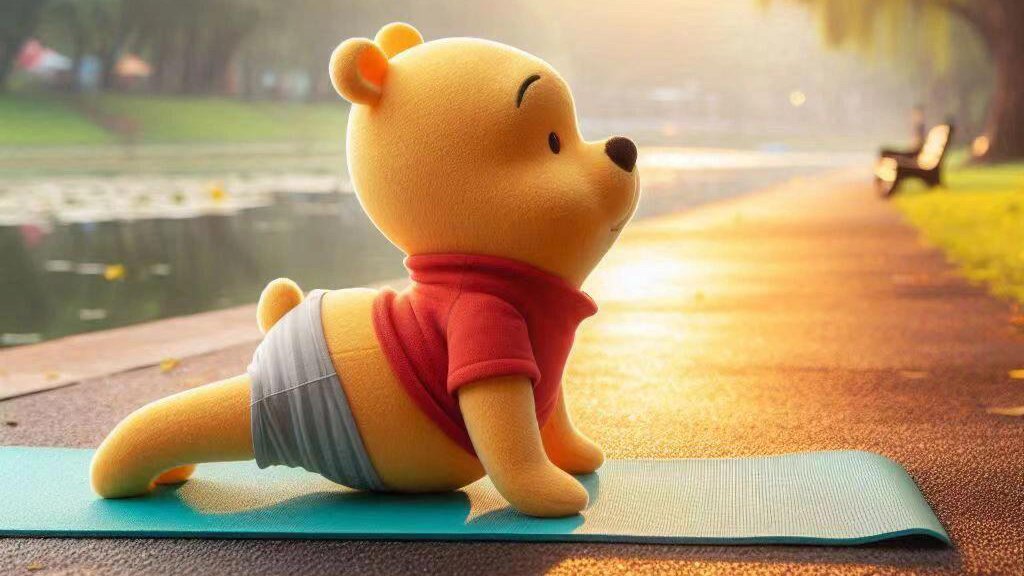Many of us suffer in our fast-paced environment in finding a peaceful night’s sleep. Would it not be fantastic if a little mindfulness could help you relax before bed? Imagine the peaceful presence of Winnie the Pooh guiding you in a basic yoga sequence to release the body and mind. Though it sounds lighthearted, this idea really stems from the relaxing quality of yoga, which has been used for ages to increase flexibility, posture, and general well-being.
Yoga is about relating your body with the surroundings, not only about stretching. Particularly for those who spend a lot of time seated, like office workers, many yoga positions resemble animals and plants and use physical motions that improve posture, increase flexibility, and relieve tension. Yoga is a perfect activity for relaxing before bed since it can help relieve back and neck pain, boost circulation, and even enhance digestion by means of mild, gradual motions.
Now let us pause to work on some relaxing stretches under the direction of Winnie the Pooh. Just fifteen minutes before bed could help you sleep much better and help to lower stress. All set to travel this road beside Pooh? Let us start.
1. Why might yoga before bed help with sleep?
Yoga’s Relationship with Sleep Quality
Relaxation—which is necessary for decent sleep—is encouraged by yoga. Before bed, several poses can help relax the nervous system, lower anxiety, and ready the body for relaxation. Yoga lets the body move deliberately and deeply, therefore enabling the body to enter a condition of relaxation fit for sleep.
How It Calms the Mind and Releases Stress
One of the most often occurring reasons for disturbed sleep is stress. By emphasizing the present and deep breathing, yoga helps offset this. This not only relaxes the body but also quiets the mind, facilitating sleep and staying asleep.
2. Knowing Yoga Poses Designed to Reflect Nature
The Power of Mimicking Nature in Yoga
The natural world—animals, plants, and elements—inspired many yoga positions. Mimicking nature in yoga is therefore quite important. Practitioners who have a connection to nature find balance and grounding. Yoga that replicates animals like the cat, cow, or downward-facing dog, for example, aligns the body in ways that improve both strength and flexibility, therefore supporting improved physical health and mental clarity.
How These Poses Support Flexibility and Relaxation
Yoga poses like those inspired by animals help to stretch and relax muscles that tend to be tight from modern lifestyles, including extended computer sitting. By releasing strain in the shoulders, back, and neck, these stretches increase flexibility and comfort.
3. Follow Pooh’s Lead with a 15-minute pre-sleep yoga routine
1. Double-Legged Stretch Pose
Instructions:
- Interlace your fingers behind your back and slowly draw your head toward your neck.
- Make sure your feet do not roll outward; keep them flat on the floor.
- Opening your chest, softly glance forward by squeezing your shoulder blades together.
- Maintaining constant breathing, hold the position for one to two minutes.

2. Corpse Pose
Instructions:
- Lie flat on your back with your feet shoulder-width apart in the corpse pose.
- Make sure your pelvis lines up so your lower back rests flat on the floor.
- Pull your chin slightly forward to gently lengthen your neck from outward rotation of your shoulders.
- Spend three to five minutes breathing naturally while relaxing your whole body.

3. Downward-Facing Dog
Instructions:
- Lift your hips toward the sky, then let your thighs, knees, and calves come off the ground in a downward-facing dog.
- Maintaining strong groundings for your hands and feet will help you to ensure your body forms an inverted V-shape.
- Steer clear of raising your shoulders to meet your ears and look ahead.
- Focus on your breathing and hold for one to two minutes.

4. Seated Forward Bend
Instructions:
- Sit on the floor with your legs stretched straight and toes pointing back towards your torso.
- On an inhale, raise your arms over your head and stretch your spine.
- Breathe out, then lean forward from your hips, maintaining a straight back.
- Spend three to five breaths focusing on deep breathing and shoulder relaxation.
- seated forward bend

5. Cobra Pose
Instructions:
- Lie flat, feet hip-width apart, and legs outstretched.
- Making sure your elbows remain bowed, gradually raise your chest by pressing the palms of your hands into the floor.
- Maintaining your glutes and legs helps you avoid stressing your lower back.
- Concentrating on stretching your spine, hold the pose for three to five breaths.

6. Seated Side Stretch
Instructions:
- Sit on the floor, making sure your hips are grounded.
- Raising one arm above your head, feel the stretch across your side of the body.
- Keeping your other arm on the floor, gaze upward toward your hand.
- As you hold the stretch for three to five breaths, really breathe deeply.

4. Tips for Incorporating Yoga into Your Sleep Routine
Consistency is Essential for Improved Sleep
Make yoga a regular part of your nightly routine if you want to get the most advantages from it before bed. Over time, even fifteen minutes of these easy poses will significantly improve your sleep quality.
Make a calm, sleep-friendly surroundings
Make sure your surroundings help you to relax before starting yoga. Turn off screens, lower the lights, and use aromatherapy or calming music to create peace. This will enable your body to get signals indicating it is time to relax and get ready for sleep.
Combine deep breathing and yoga
Including deep breathing in your yoga practice will help to improve its relaxing qualities. Try holding the breath for a few seconds, then gently exhale from your nose. This will enable the body to start its relaxation reaction, facilitating falling asleep.
Frequently Asked Questions (FAQ)
Indeed, yoga is a great approach to relax the body and the mind, therefore facilitating easier falling asleep. Some positions are especially meant to release tension and stress, which are typical obstacles to effective sleep.
One can get the advantages of yoga before bed in fifteen minutes. If you have more time, though, you can broaden your practice.
Correct! These are easy positions fit for novices. Just be sure you pay attention to your body and steer clear of demanding too much from yourself.
Not quite at all. As you grow more familiar with the practice, progressively add more from a few poses you are most comfortable with
Indeed, yoga can increase flexibility, lower tension, ease back discomfort, enhance digestion, and even aid with brain clarity and attention.
It would be advisable to avoid yoga or see a doctor if you ate a big dinner immediately before bed or if you are physically injured.
6. Conclusion: Pooh’s Yoga’s Calming Pre-Sleep Routine
For anyone having trouble sleeping, including a brief yoga session before bed can be revolutionary. Just 15 minutes of deliberate movement will help you to unwind your body, clear your head, and get ready for a peaceful night’s sleep. So why not try these gentle stretches tonight and welcome your inner Pooh?








